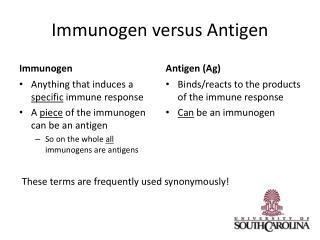An immunogen is an antigen or any substance that may be specifically bound by components of the immune system (antibody, lymphocytes). The term antigen arises from its ability to induce generation of antibodies (antigen = antibody generation). Despite the fact that all antigens are recognized by specific lymphocytes or by antibodies, not every antigen can evoke an immune response. Those antigens that are capable of inducing an immune response are said to be immunogenic and are called immunogens.
An immunogen is any antigen that is capable of inducing humoral and/or cell-mediated immune response rather than immunological tolerance. This ability is called immunogenicity. Sometimes the term immunogen is used interchangeably with the term antigen. But only an immunogen can evoke an immune response.
Generally, both are substances that are capable of generating antibodies (antigen) or immune responses (immunogen).
We can define an immunogen as a complete antigen which is composed of the macromolecular carrier and epitopes (determinants) that can induce immune response.
An explicit example is a hapten. Haptens are low-molecular-weight compounds that may be bound by antibodies, but cannot elicit an immune response. Consequently, the haptens themselves are nonimmunogenic and they cannot evoke an immune response until they bind with a larger carrier immunogenic molecule. The hapten-carrier complex, unlike free hapten, can act as an immunogen and can induce an immune response.
Until 1959, the terms immunogen and antigen were not distinguished.
Keyhole Limpet Hemocyanin (KLH)It is copper-containing respiratory protein, isolated from keyhole limpets (Megathura crenulata). Because of its evolutionary distance from mammals, high molecular weight and complex structure it is usually immunogenic in vertebrate animals.
Concholepas Concholepas Hemocyanin (CCH)(also Blue Carrier Immunogenic Protein) It is alternative to KLH isolated from Concholepas concholepas.It has the similar immunogenic properties as KLH but better solubility and therefore better flexibility.
Bovine Serum Albumin (BSA)It is from the blood sera of cows and has similarly immunogenic properties as KLH or CCH. The cationized form of BSA (cBSA) is highly positively charged protein with significantly increased immunogenicity. This change possesses a greater number of possible conjugated antigens to the protein.
Ovalbumin (OVA)Also known as egg albumin, the main protein (60-75% ) found in hen egg white. OVA is being soluble in Dimethyl Sulfoxide (DMSO) that enables conjugation of haptens that are not soluble in aqueous buffers. Immune response can be enhanced by using an ajuvant injected together with the immunogen.An adjuvant (from Latin adiuvare – to help) is any substance, distinct from antigen, which enhances immune response by various mechanisms: recruiting of professional
antigen-presenting cells (APCs) to the site of antigen exposure; increasing the delivery of antigens by delayed/slow release (depot generation); immunomodulation by cytokine production (selection of Th1 or Th2 response); inducing
T-cell response (prolonged exposure of peptide-MHC complexes [signal 1] and stimulation of expression of T-cell-activating co-stimulators [signal 2] on the APCs' surface) and targeting (e. g. carbohydrate adjuvants which target
lectin receptors on APCs). Adjuvants have been used as additives to improve vaccine efficiency since the 1920s. Generally, administration of adjuvants is used both in experimental immunology and in clinical settings to ensure a high quality/quantity memory-enhanced antibody response, where antigens must be prepared and delivered in a fashion that maximizes production of a specific immune response. Among commonly used adjuvants are Complete and Incomplete
Freund's adjuvant and solutions of aluminum hydroxide or aluminum phosphate.

